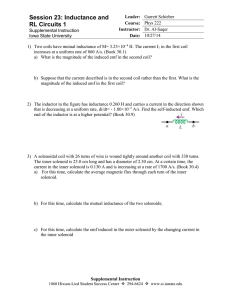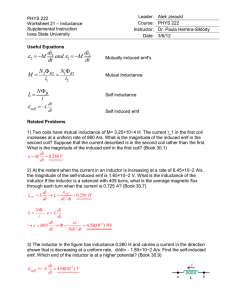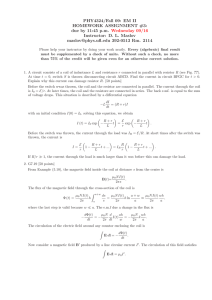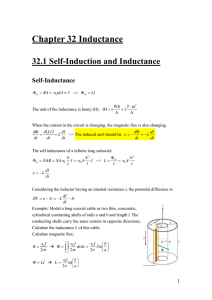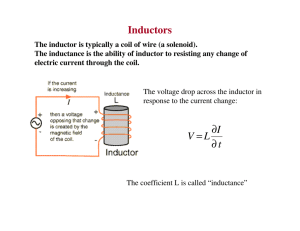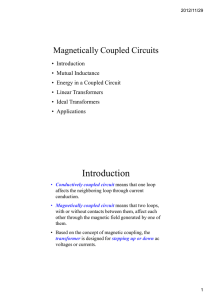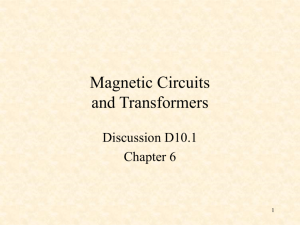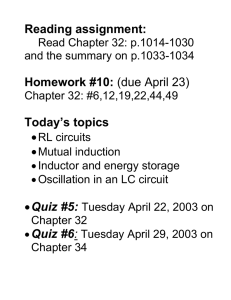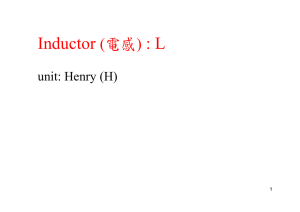13-Mutual Inductance
advertisement
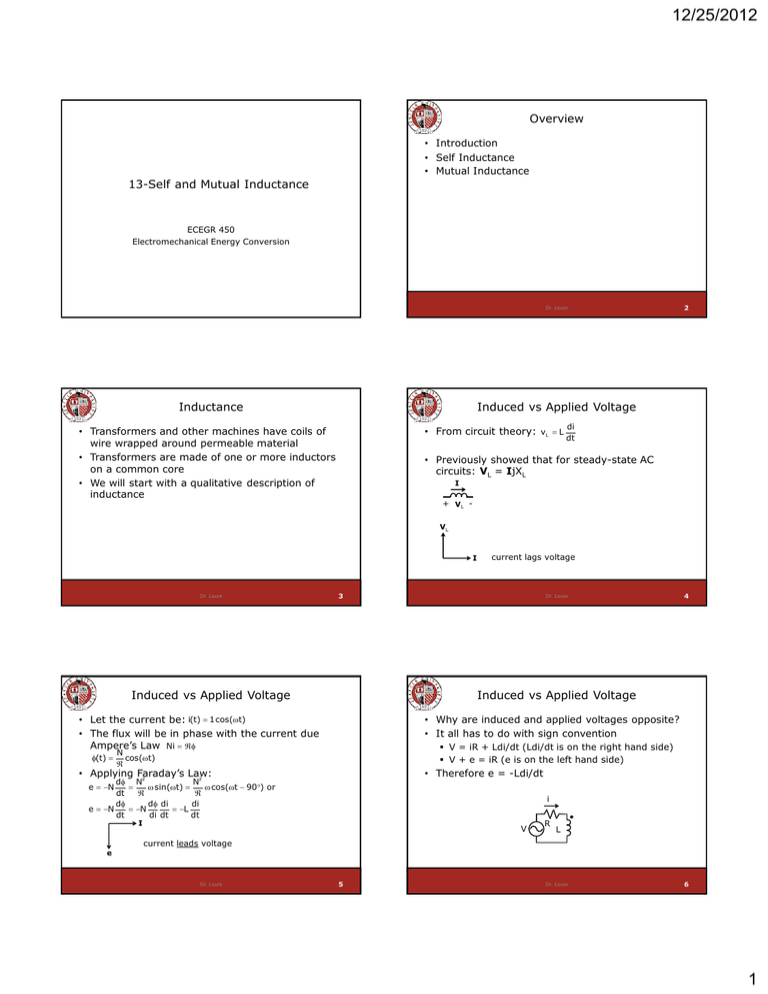
12/25/2012 Overview • Introduction • Self Inductance • Mutual Inductance 13-Self and Mutual Inductance ECEGR 450 Electromechanical Energy Conversion Dr. Louie Inductance 2 Induced vs Applied Voltage • Transformers and other machines have coils of wire wrapped around permeable material • Transformers are made of one or more inductors on a common core • We will start with a qualitative description of inductance • From circuit theory: vL L di dt • Previously showed that for steady-state AC circuits: VL = IjXL I + VL VL I Dr. Louie 3 Induced vs Applied Voltage Dr. Louie 4 Induced vs Applied Voltage • Let the current be: i(t) 1cos(t) • The flux will be in phase with the current due Ampere’s Law Ni (t) current lags voltage • Why are induced and applied voltages opposite? • It all has to do with sign convention V = iR + Ldi/dt (Ldi/dt is on the right hand side) V + e = iR (e is on the left hand side) N cos(t) • Applying Faraday’s Law: 2 2 • Therefore e = -Ldi/dt d N N sin(t) cos(t 90) or dt d d di di e N N L dt di dt dt e N i I e V R L current leads voltage Dr. Louie 5 Dr. Louie 6 1 12/25/2012 Inductance Inductance • Inductive reactance XL exists due to Faraday’s Law • Recall that d (note the polarity in the figure) eN dt jXL = jωL N is also known as the flux linkages (λ) • The j operator accounts for the 90 degree phase shift between current and induced voltage • ω accounts for the dependency on frequency • L is a description of how strong the current links the flux through the coil • Next we examine inductance i + e - - 7 Dr. Louie • Inductance depends on the physical characteristics of the magnetic circuit • Recall that Ni d L N therefore di 2 N L • Inductance is constant if the permeability of the magnetic circuit is itself constant (not the case in ferromagnetic materials) • We will assume that we are operating in the linear region of B-H curve d N di • Large inductance: great sensitivity of flux wrt current i + V e - - Inductance describes how the flux linking a coil changes with the applied current N 9 Dr. Louie Question Which circuit has greater inductance? A. 10 Dr. Louie Question Which circuit has greater inductance? B. i 8 Self Inductance • Self-inductance (inductance) is defined as: + N Dr. Louie Inductance L + V A. i B. i i Smaller reluctance. Current gives rise to greater flux Dr. Louie 11 Dr. Louie 12 2 12/25/2012 Self Inductance Mutual Inductance • Consider two coils wrapped around a common core • Let 1 be the flux that links coil 1 • Inductance is related to emf by: d d di di eN N L dt di dt dt • A coil with 1 H of inductance will have 1 volt induced in it if the current changes at a rate of 1 A/s • If we know the inductance, we do not need to compute the flux Includes leakage flux (1l) and flux through the core that links coil 2 (21) With coil 2 open: 1 = 1l + 21 i1 1l i 21 + e1 - N1 13 Dr. Louie Mutual Inductance • Induced voltage in coil 1 is: • Induced voltage in coil 2 is: d21 d21 di1 di e2 N2 N2 M21 1 dt di1 dt dt d1 di L1 1 dt dt d21 di1 M21: mutual inductance from coil 1 to coil 2 • L1: self inductance of coil 1 M21 i1 + e1 - N2 i N1 21 + e1 - open circuit N2 N1 15 Dr. Louie d 2 di L2 2 dt dt d d di di e1 N2 12 N1 12 2 M12 2 dt di2 dt dt e2 N1 open circuit d12 di2 + e1 - 2l 12 N1 N2 Dr. Louie + e2 open circuit - 16 Mutual Inductance • Similar expressions can be derived in coil 2 if it is connected to the source and coil 1 is open N1 N2 Dr. Louie Mutual Inductance M12 14 Dr. Louie Mutual Inductance e1 N1 open circuit N2 • We can write: M12M21 N2 d21 d12 N di1 1 di2 • Let k1 be the fraction of the flux of coil 1 that links coil 2 21 k11 • Let k2 be the fraction of the flux of coil 2 that links coil 1 12 k22 • Since L N d we can write: M12M21 k1k 2L1L 2 i di + e2 - 17 Dr. Louie 18 3 12/25/2012 Mutual Inductance Mutual Inductance • If the system is linear (standard assumption) then: • The circuit equivalent is: i2 i1 M12 M21 M M: mutual inductance of coil 1 and coil 2 R1 • And we can reduce R2 L2 L1 M12M21 k1k 2L1L 2 to M k L1L 2 i1 k k1k 2 + e1 - k: coefficient of coupling k = 1 (tightly coupled coils, no leakage) k = 0 (magnetically isolated coils) Dr. Louie Polarity dots indicate which way the coils are wound. If current enters one dot, it leaves the other if connected to a passive circuit. i2 N1 19 N2 Dr. Louie + e2 - 20 Example Example Two identical coils are wound on the same magnetic core. A current changing at a rate of 2000 A/s in coil 1 induces a voltage of 20 V in coil 2. What is the mutual inductance? Two identical coils are wound on the same magnetic core. A current changing at a rate of 2000 A/s in coil 1 induces a voltage of 20 V in coil 2. What is the mutual inductance? di1 dt M21 M e2 M21 M12 M Dr. Louie e2 20 0.01H di1 2000 dt 21 Dr. Louie 22 Example Example Two identical coils are wound on the same magnetic core. A current changing at a rate of 2000 A/s in coil 1 induces a voltage of 20 V in coil 2. If L 1 = 25mH, what percentage of the flux set up by coil 1 links coil 2? Two identical coils are wound on the same magnetic core. A current changing at a rate of 2000 A/s in coil 1 induces a voltage of 20 V in coil 2. If L 1 = 25mH, what percentage of the flux set up by coil 1 links coil 2? L1 L 2 L 0.25mH M k L1L 2 kL k Dr. Louie 23 0.01 100 40% 0.025 Dr. Louie 24 4 12/25/2012 Magnetically Coupled Coils Magnetically Coupled Coils • It is possible to connect the magnetically coupled coils together series or parallel • Depending on the polarity the coils can be aiding or opposing • See 2.6 of text for more details L1 L2 L1 Series Aiding L2 • For aiding circuits: di di di M (L1 M) M is added dt dt dt because of aiding di di di polarity VL2 L 2 M (L 2 M) dt dt dt di di VLeff VL1 VL2 (L1 L 2 2M) L eff dt dt where M L eff L1 L 2 2M L2 L1 VL1 L1 I Vs Series Opposing 25 Dr. Louie R 26 Dr. Louie Example Example The circuit below operates at 50Hz. The mutual inductance M between the coils is 0.6 H. Compute I. The circuit below operates at 50Hz. The mutual inductance M between the coils is 0.6 H. Compute I. L eff 1 1.5 2 0.6 3.7 H Mutual inductances add in aiding jXeff j3.7 2 50 j1162 W circuits Z 0.5 j1162 W I 0.238 89.98 A 1H 1.5H I Vs 2770 1H 1.5H I Vs 2770 0.5W 27 Dr. Louie 0.5W 28 Dr. Louie Example Example Repeat the problem but with opposing polarity of the inductors. Repeat the problem but with opposing polarity of the inductors. L eff 1 1.5 2 0.6 1.3 H jXeff j1.3 2 50 j408.4 W Z 0.5 j408.4 W I 0.68 89.93 A 1H 1.5H Vs 2770 I Dr. Louie 1H 1.5H Vs 2770 0.5W 29 I Dr. Louie 0.5W 30 5
